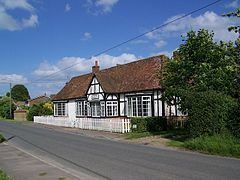OS grid reference SU123372 Unitary authority Dialling code 01722 Population 443 (in 2011) | Civil parish Woodford Sovereign state United Kingdom Postcode district SP5 | |
 | ||
Woodford is a civil parish in southern-central Wiltshire, England, on the west bank of the Salisbury Avon, about 4 miles (6 km) north of Salisbury. Its settlements are the villages of Lower Woodford, Middle Woodford and Upper Woodford, the last of which is the largest of the three. In 1871, the population was 523; in 1951, this had decreased to 405 people.
Contents
Map of Woodford, UK
In 972, the name was recorded as Wuduforda, which in Old English means "ford in or by a wood", from wudu + ford. In the nineteenth century it was pronounced 'oodford.
History
Woodford is mentioned in the days of Henry III, namely there being a knight, Sir William Woodford of Woodford. A palace existed here, used by the Bishops of Salisbury, but only a few carved stones remain on the site; the palace was the hiding place of Charles II after the Battle of Worcester in September 1651. The buildings of Druid's Lodge (also known as Woodford Hut), in the north-west of the parish, were used as a prisoner-of-war camp during the Second World War, but they no longer exist. Nearby there is a small stone shelter, erected as a memorial to Lieutenant Colonel F. G. G. Bailey (d. 1951), who resided at Lake House, Wilsford. Woodford Church of England Primary School was erected between 1833 and 1836, and increased in size in 1854. In 1880 the chief landowners were Ecclesiastical Commissioners, and Robert Loder.
Geography
Woodford is approximately 2,780 acres (1,130 ha) in size. On a hill slope southwest of Druid's Head, there is a large and old enclosure that was formed by a bank.
Lower Woodford Water Meadows is a 23.9 hectares (59 acres) biological Site of Special Scientific Interest in Lower Woodford, notified in 1971. Of the working water-meadows in southern England that are associated with chalk streams, the best is situated at Lower Woodford.
Notable buildings
Heale House, near Middle Woodford, is Grade I listed and is an example of Georgian architecture that dates to around 1730; it is surrounded by notable gardens. Additions were made to the house in 1894 by Detmar Blow.
The Church of England parish church of All Saints at Middle Woodford is Grade II listed. It has 12th-century origins but was much restored in 1845 by T.H. Wyatt. A monument to Gerard Erington of Heale is dated 1596.
At Lower Woodford, the 17th-century Manor House is Grade II listed. Avon Cottage, a timber-framed house originally built in the 15th century, was recased in red brick in the late 18th or early 19th century, with 20th-century additions to the south and east. The collar-beam roof was reconstructed in the late 16th or early 17th century when a ceiling was added in the hall.The Court House, on the eastern side of the road, was part of Woodford Manor estate until 1920 when it was sold to Major General Aston.
Amenities
Woodford Valley C.E. Primary Academy serves the villages and surrounding parishes. The site began as a National school in 1872.
There are two pubs: the Bridge Inn at Upper Woodford and the Wheatsheaf Inn at Lower Woodford.
The Monarch's Way long-distance footpath passes through Lower and Middle Woodford.
